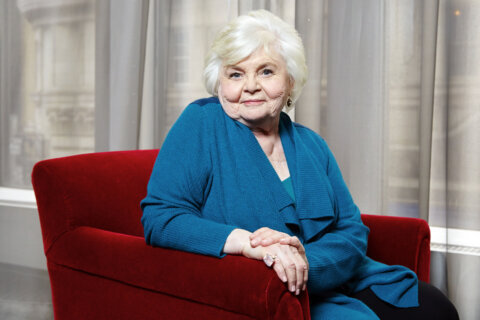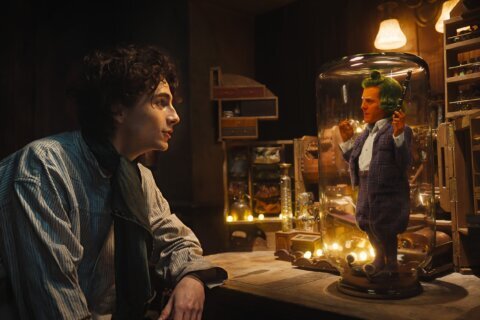WASHINGTON — Only a few filmmakers make us circle our calendars in excited anticipation for their next project.
Christopher Nolan is one of them.
He’s wowed us time after time, bursting on the scene with his backwards, amnesiac mystery “Memento,” (2000); gripping us with Al Pacino hunting Robin Williams in “Insomnia” (2002); pitting Christian Bale against Hugh Jackman as dueling magicians in “The Prestige” (2006); sending Leo DiCaprio into dreams-within-dreams in “Inception” (2010); and reinventing the superhero genre in “The Dark Knight Trilogy” (2005-2012).
As a result, legions of Nolanites tattooed a “Nov. 4” reminder on their chests, planted the date in their subconscious memories and carved a Joker smile on their faces, all awaiting Nolan’s new sci-fi epic adventure “Interstellar.”
Set in the dusty Midwest of the near future, a widower named Cooper (Matthew McConaughey) has given up his dream job as a NASA pilot to become a farmer after a dwindling food supply threatens mankind’s existence. With the help of his father-in-law (John Lithgow, “Third Rock from the Sun”), he raises his two kids, 15-year-old Tom (Timothee Chalamet, who grows up to be Casey Affleck) and 10-year-old Murph (Mackenzie Foy, who grows up to be Jessica Chastain). The latter is fittingly named after Murphy’s Law, which she interprets as, “Anything that can go wrong, will go wrong,” while Cooper insists it means, “Anything that can happen, will happen.”
It’s this notion that drives Murph and Coop to investigate a paranormal experience on the family bookshelf, leading to a secret government base run by Professor Brand (Michael Caine, “Batman Begins”). He recruits Cooper to join his daughter Amelia (Anne Hathaway, “The Dark Knight Rises”), fellow astronaut Doyle (Wes Bentley, “American Beauty”) and a snarky robot named TARS (Bill Irwin) to explore a wormhole near Saturn in search of a new home for the human race.
Immediately, Cooper faces a moral dilemma. Should he venture out to save mankind, or stay behind to protect his family on earth? What would you do in that spot?
Such a juicy role befits our reigning Best Actor winner. McConaughey goes from “Dallas Buyers Club” to “Houston, we have a problem,” while weaving in the Middle-American grit of “Mud,” the entrepreneurial spirit of “The Wolf of Wall Street,” and the philosophical star-gazing of HBO’s “True Detective.” He is uniquely suited to deliver life’s existential questions, even if the McConaissance brand now seems sillier after Jim Carrey’s “SNL” spoof: “Sometimes you gotta go back to actually move forward … like go from winning an Oscar to doing a car commercial.”
“Interstellar” doesn’t mark a step back for McConaughey; it’s one small step for man, one giant leap for the McConaissance. His pairing with Hathaway may lack the chemistry of George Clooney and Sandra Bullock in “Gravity” (2013), but I dare any viewer not to choke up a bit as McConaughey crumbles into a pool of tears while watching his daughter’s anguished video transmissions.
Much of the credit belongs to the three actresses portraying the daughter, first with Foy as a young girl losing her father, then with Chastain as a middle-aged woman dealing with past scars, and finally with Ellen Burstyn as an elderly woman looking back on a full life. Chastain deserves special praise for her deeply emotional performance, continuing her comet streak since “The Help” (2011), “Zero Dark Thirty” (2012) and “The Disappearance of Eleanor Rigby” (2014).
Yet watching Chastain, we can’t help but think of her role in “The Tree of Life” (2011), where director Terrence Malick tackled life’s big questions in a far more ethereal way than Nolan here.
Make no mistake about it: Nolan is a masterful filmmaker, able to create pop art out of mainstream blockbusters. He admirably favors practical effects over CGI, from the semi-truck flipping in “The Dark Knight” to the rotating room in “Inception.” At times, “Interstellar” reminds us of his very best qualities, particularly as Cooper’s truck drives away to the sound of a launchpad countdown. At other times, it reminds us of familiar flaws in his ambitious approach — stretched out over a redundant three hours.
Act One is absolutely riveting with human drama, as McConaughey’s obsession causes him to forsake his family like Richard Dreyfus in “Close Encounters of the Third Kind” (1977), interpreting signs to arrive at a secret government site. The segment also blends “The Grapes of Wrath” (1940) with Dust Bowl hardship, “Field of Dreams” (1989) with a dreamer father plowing through corn, and “The Right Stuff” (1983), mourning a sort of American exceptionalism that Nolan suggests has been lost.
As McConaughey says, “We used to look up at the sky and wonder at our place in the stars. Now we just look down and worry about our place in the dirt.” The rest of society replies, “The world doesn’t need any more engineers. We didn’t run out of planes and television sets. We ran out of food.” Even Murph’s teacher pushes a revisionist history where the 1969 moon landing was supposedly faked (one of many nods to Stanley Kubrick, who is rumored to have shot the fake landing).
As we launch into space, Act Two becomes a mixed bag. Nolan mesmerizes us with wondrous visual effects by Paul J. Franklin (“Inception”), gorgeous cinematography by Hoyte van Hoytema (“Her”), theater- rattling organ music by Hans Zimmer (“Gladiator”) and a surprise appearance by one of Hollywood’s biggest actors. But while the sensory experience keeps us in awe, the half-baked script tests our patience, offering redundant docking scenes and dialogue soaked with exposition.
“Inception” was insanely cool, but had similar exposition. Nolan crafted a plot so complex that characters had to literally tell the audience exactly what was happening so we could follow the “dreams within dreams” logic. It’s a tradeoff — enduring force-fed information for high concept enjoyment.
“Interstellar” bombards us with explanations of space, time, relativity and quantum physics. No doubt each concept was run by theoretical physicist Kip Thorne, who serves as Executive Producer. It’s a challenging balancing act for Nolan and his co-writer brother Jonathan, who need to “science it up” for authenticity without alienating the audience. Occasionally, they strike the right balance — explaining a wormhole by bending a sheet of paper — but as the characters keep talking, we get lost in the technical jargon. Instead of a poetic script, we feel like we’re reading a space shuttle manual.
Somewhere in these scientific concepts, we learn that for the characters, every hour on a faraway planet equals seven years on earth. Act Three feels a bit like this — every hour on screen feels like seven years in your theater seat. To paraphrase “Alien” (1979): In space, no one can hear you scream, but they can hear you snore. Grab a coffee and a notepad. You’re gonna need it.
By the end, the film feels more contrived than transcendent. It builds toward an ending that attempts to cross dimensions, but it’s presented so tidy that it almost feels hokey. If you’re going for a highbrow mind bender, why not generate thought-provoking discussion with ambiguity like Kubrick’s “2001: A Space Odyssey” (1968)? Or, if you’re going to be obvious, you better make every second count like Alfonso Cuaron’s “Gravity” (2013), which had us gasping for air after 90 minutes.
Maybe it’s unfair to compare Nolan to a legend such as Kubrick, or even a contemporary such as Cuaron. More importantly, it may be unfair to compare “Interstellar” to Nolan’s own best work. Either way, “Interstellar” joins Darren Aronofsky’s “Noah” as my two most disappointing movies of the year, and not because they’re bad. On the contrary, they’re both well worth watching as ambitious, immersive cinematic experiences directed by legends in their own time. They’re merely disappointing because auteur filmmakers face the unreal expectation of creating mind-blowing masterpieces each time out, occasionally falling flat compared to the rest of their own stellar filmographies.
When the trailers were first released, it appeared that “Interstellar” might just be the film to finally win Nolan a long-overdue Oscar. After seeing the movie, you’ll wish the result were more like the goosebump-inducing teasers. But while Nolan may not follow in Cuaron’s award-winning footsteps, he has once again proven his reputation to dream big, his desire to push the boundaries, and — if you see it in glorious 70 millimeter IMAX — his uncanny ability to deliver the visual experience of the year.
It may be a flawed Nolan epic, but any film that defines love as a tangible force in the universe is worth something. Its messaging may be scattered like stars across a galaxy, but its heart is in the right place.
★ ★ ★
The above rating is based on a 4-star scale. See where this film ranks in Jason’s Fraley Film Guide. Follow WTOP Film Critic Jason Fraley on Twitter @JFrayWTOP, read his blog The Film Spectrum, listen Friday mornings on 103.5 FM and see a full list of his stories on our “Fraley on Film” page.








